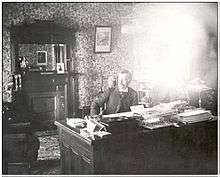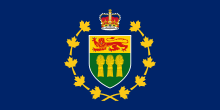Lieutenant Governor of Saskatchewan
| Lieutenant-Governor of Saskatchewan | |
|---|---|
|
Emblem of the Lieutenant Governor | |
| Viceroy | |
| Style | Her Honour the Honourable |
| Appointer | Governor General of Canada |
| Term length | At the Governor General's pleasure |
| Formation | 1 September 1905 |
| First holder | Amédée E. Forget |
| Website | www.ltgov.sk.ca |

The Lieutenant-Governor of Saskatchewan /lɛfˈtɛnənt/ is the viceregal representative in Saskatchewan of the Canadian monarch, Queen Elizabeth II, who operates distinctly within the province but is also shared equally with the ten other jurisdictions of Canada, as well as the other Commonwealth realms and any subdivisions thereof, and resides predominantly in her oldest realm, the United Kingdom. The Lieutenant-Governor of Saskatchewan is appointed in the same manner as the other provincial viceroys in Canada and is similarly tasked with carrying out most of the monarch's constitutional and ceremonial duties.[1] The present, and 21st, Lieutenant-Governor of Saskatchewan is Vaughn Solomon Schofield, who has served in the role since 22 March 2012.[2]
Role and presence
The Lieutenant-Governor of Saskatchewan is vested with a number of governmental duties and is also expected to undertake various ceremonial roles. For instance, the lieutenant-governor acts as patron, honorary president, or an honorary member of certain Saskatchewan institutions, such as the Saskatchewan Music Festival Association, the Saskatchewan Craft Council, and the provincial poet laureate program. Further, Saskatchewan's lieutenant-governor acts, by law, as the visitor to both the University of Saskatchewan and the University of Regina, and under special circumstances may be called upon in this role, as happened in the University Crisis of 1919 at the University of Saskatchewan. The lieutenant-governor, him or herself a member and Chancellor of the order,[3] will induct deserving individuals into the Saskatchewan Order of Merit and, upon installation, automatically becomes a Knight or Dame of Justice and the Vice-Prior in Saskatchewan of the Most Venerable Order of the Hospital of Saint John of Jerusalem.[4] The viceroy further presents other provincial honours and decorations, as well as various awards that are named for and presented by the lieutenant governor; these are generally created in partnership with another government or charitable organization and linked specifically to their cause.[5] These honours are presented at official ceremonies, which count amongst hundreds of other engagements the lieutenant-governor partakes in each year, either as host or guest of honour; in 2006, the Lieutenant-Governor of Alberta undertook 250 engagements and 450 in 2007.[6]


At these events, the lieutenant-governor's presence is marked by the lieutenant-governor's standard, consisting of a blue field bearing the escutcheon of the Arms of Her Majesty in Right of Saskatchewan surmounted by a crown and surrounded by ten gold maple leaves, symbolizing the ten provinces of Canada. Within Saskatchewan, the lieutenant-governor also follows only the sovereign in the province's order of precedence, preceding even other members of the Canadian Royal Family and the Queen's federal representative. The former Lieutenant-Governors of Saskatchewan are also honoured in official portraits collected together in the dedicated Qu'Appelle Gallery in the Saskatchewan Legislative Building.
History
The office of Lieutenant-Governor of Saskatchewan came into being in 1905, upon Saskatchewan's entry into Canadian Confederation,[7] and evolved from the earlier position of Lieutenant-Governor of the North-West Territories. Since that date, 20 lieutenant-governors have served the province, amongst whom were notable firsts, such as Sylvia Fedoruk – the first female lieutenant-governor of the province. The shortest mandate by a Lieutenant-Governor of Saskatchewan was Thomas Miller, from 27 February 1945 to 20 June 1945, while the longest was Henry William Newlands, from 18 February 1921 to 30 March 1931.
It was in 1929 that the Lieutenant-Governor of Saskatchewan's personal discretion was required in the exercise of the Royal Prerogative, when Henry Newlands had to select a new Premier after James Garfield Gardiner lost the confidence of the Legislative Assembly and the opposing Progressive Conservative Party had managed to form a coalition with the Progressive Party and independent members of the assembly.[8] With the election in 1944 of the Co-operative Commonwealth Federation Party to a majority in the Legislative Assembly, the Office of the Lieutenant Governor in Saskatchewan was targeted for spending cutbacks. Government House was closed and the viceroy given only a small office at the Hotel Saskatchewan as a replacement, and guards of honour and playing of the Viceregal Salute were dispensed with. This trend continued, due to lack of initiative rather than hostility towards the Crown, until the 1980s when the viceroy's honours were restored and Government House was saved from demolition.[8]
See also
References
- ↑ Victoria (29 March 1867), Constitution Act, 1867, V.58, Westminster: Queen's Printer, retrieved 15 January 2009
- ↑ Vaughn Solomon Schofield Becomes Provinces 21st Lieutenant Governor, retrieved 22 March 2012
- ↑ Elizabeth II (29 June 1988), The Provincial Emblems and Honours Act, III.15, Regina: Queen's Printer for Saskatchewan
- ↑ Canada Wide > About Us > The Order of St. John > The Order of St. John in Canada, St. John Ambulance Canada, retrieved 2 June 2009
- ↑ Office of the Lieutenant Governor of Saskatchewan, The Office > Honours and Awards, Queen's Printer for Saskatchewan, retrieved 1 July 2009
- ↑ Berezovsky, Eugene (2009), Staff of Canadian Monarchist News, ed., $1.52 per Canadian: The Cost of Canada's Constitutional Monarchy (PDF) (4 ed.), Toronto: Monarchist League of Canada, p. 3, retrieved 15 May 2009
- ↑ Edward VII (20 July 1905), Saskatchewan Act, 10, Westminster: King's Printer, retrieved 16 June 2009
- 1 2 Jackson, Michael D. (2007), "The Crown in Today's Federal State" (PDF), Canadian Monarchist News, Toronto: Monarchist League of Canada, Autumn-Winter 2007 (27): 11, retrieved 5 July 2009
